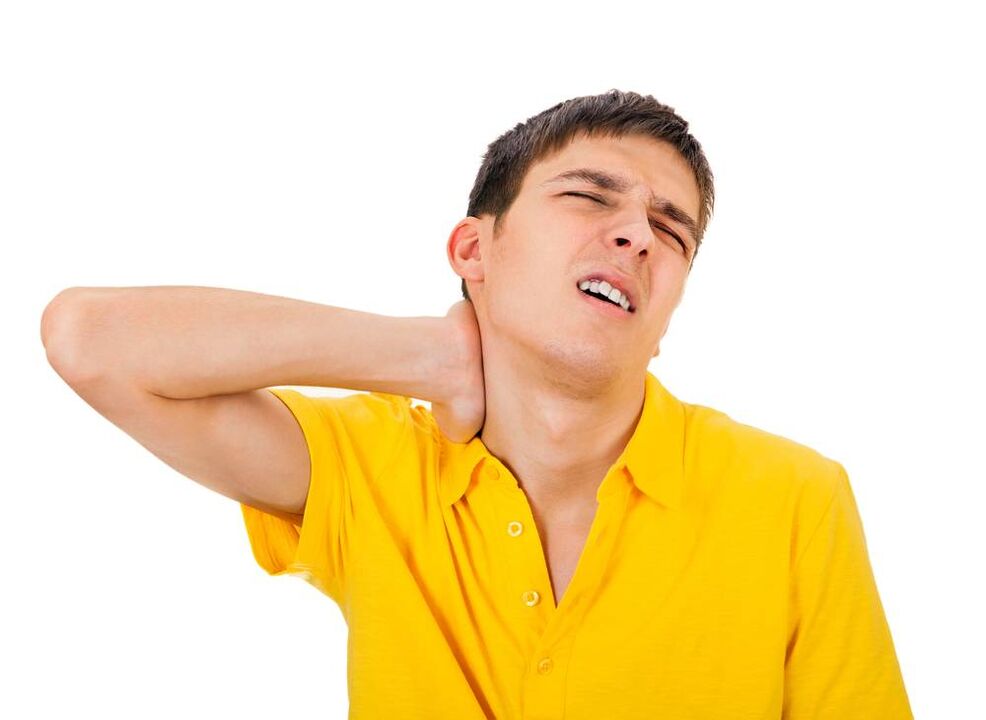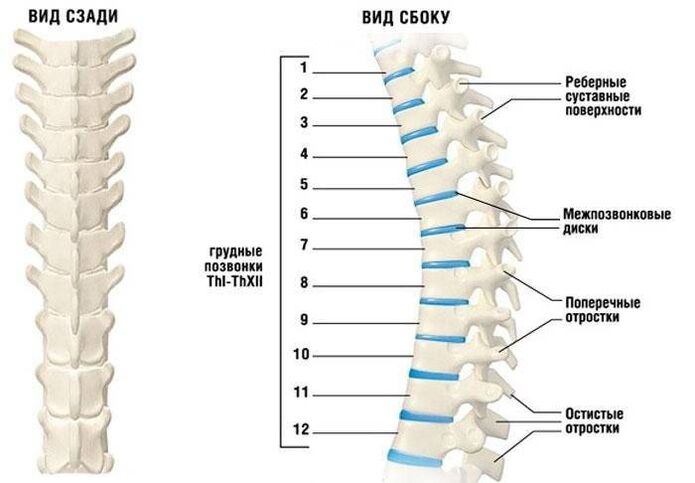Currently, according to medical statistics, almost all people over the age of 25-30 complain of symptoms of cervical osteochondrosis.The disease affects this spine more often than others.Pathology is a progressive degenerative process that affects the intervertebral discs and vertebrates in the neck.The disease is common in men and women the same.This is a dangerous and complex form of osteochondrosis, as large blood vessels that supply the brain and large numbers of nerve endings are located in the neck.Disruption of innervation and blood flow causes deterioration in the brain to oxygen and nutrients.

Signs of the disease
Symptoms of osteochondrosis of the cervical spine are more pronounced than in other parts of the spinal column, even with minor injuries.This is due to the fact that the vertebrates in the neck are close to each other, and the intervertebral discs are small.Such anatomical properties contribute to the fact that osteochondrosis, nerve endings, spinal cord, blood vessels are more often compressed.
General Symptoms:
- Pain syndrome;
- Weakness and decreased sensitivity to the upper extremities;
- Restriction of neck mobility;
- Disruption of coordination of movements;
- Frequent dizziness;
- General weakness;
- Deterioration of the functioning of the perception organs (hearing, vision, touch, taste).
Pains are more often localized to the neck, give them to the back, shoulders, arms.The upper extremities will hurt if the nerve is located by the damaged spine, which is responsible for their innervation.The pain in the back is caused by spastic compression of the neck muscles, which are attached to the bones of the neck and disrupted blood flow to this area.
The weakness of the hands is observed in patients if the nerve spine participates in the pathological process, which ensures the innervation of the upper extremity muscle structures.Restoration of mobility and characteristic crispy when the neck returns or is angled, if the cervical vertebrates appear during bone growth, the height of the intervertebral discs decreases, the joints between the vertebrates are affected.
Neck vertebrates have transverse processes that form a channel in which the artery that feeds on the brain.With osteochondrosis of the cervical spine, the vertebrates are displaced, with the connective tissue growing on them.This causes the cervical artery compression, deterioration of blood supply to the cerebrum, and the back of the brain.As a result, people have frequent dizziness, coordination of movements, general weakness.In advanced cases, if the artery is involved in the pathological process or is strongly forced, then the cerebral blood supply, the ocpital part, and the stem of the brain will deteriorate significantly.In this case, the functioning of hearing and vision organs is reduced, the tongue and the fingers are reduced.
Signs of the disease depend on which of the eight vertebrates affects the dystrophic or inflammatory process.Sensitivity and movement disorders cause damage to the cerebrospinal roots, which are affected by certain vertebrates.According to this, the following manifestations of cervical osteochondrosis are noted:

- The first vertebrates - part of the neck and head of the head are dimmed, their sensitivity decreases;
- Second - pain is felt in crowns and fissures;
- Third - the pain is felt and the sensitivity is reduced in the part of the neck, where the spinal spine is reddish, the intensity of the senses of taste decreases, and speech deficiencies exist;
- Fourth - The pain emits the shoulder, scapula, the patient is concerned with heartache, shortness of breath, and the tone of the neck muscles;
- Fifth - Pain is observed in the neck, which is given the outer surface of the shoulder;
- Sixth - The pain in the neck emits the shoulder blade, the forearm and fingers are felt;
- Seventh - Pain is given a shoulder blade, shoulder to the back, forearm and fingers (second to fourth);
- Eighth - Pain from the neck to the shoulders, forearm and small finger.
Depending on the prevalence of injury, the cervical spine is four degrees of osteochondrosis.This is not the stage of the disease, but the severity of the symptoms, due to how widespread the pathological process is, the effect of the vertebrates.
- In the first degree, the clinical symptoms do not exist or manifest to be minimized.Patients complain of slight pain, intense during head movements.Treatment at this stage of the disease will be effective.However, people often neglect annoying symptoms or do not feel them, so they do not consult a doctor.
- Exacerbation of the abnormal process exacerbates the symptoms.In the second stage, the pain becomes more pronounced, give the upper limbs, shoulder blades.At this stage of the development of the degenerative process, the height of the intervertebral disc decreases, resulting in nerve fiber.This is the cause of increased pain.The second degree of osteochondrosis of the cervical region is characterized by the appearance of headaches, deterioration of well -being, and decreased work capabilities.
- The third degree of cervical osteochondrosis is distinguished by the affected intervertebral disc hernia.Neck mobility is limited, with palpation the patient feels severe pain.With this spread of the abnormal process, the pain becomes permanent, radiating the upper extremities.Muscle tension attached to the gastrointestinal bones is felt.Patients complain of frequent dizziness, general weakness, and hands.
- The fourth degree of cervical osteochondrosis is diagnosed when the intervertebral disc is completely destroyed by the dystrophic process.It has been replaced by fiber fabric, which results in a significant restriction on mobility.The spinal cord and blood vessels fly around the neck.Such changes are characterized by a significant deterioration of blood supply to the cerebrum and the stomach of the brain.Oxygen starvation causes coordination of movements, hearing loss, vision, tongue, speech disorders.
Methods of treatment
In a timely manner, when the first alarm symptoms appear, the neck is unpleasant sensations, and the reaction from the nervous system will prevent the progression of degenerative changes.Treatment of cervical osteochondrosis involves a complex of therapeutic measures.Including:
- Taking medication;
- Massage;
- Physical education of physiotherapy;
- Physiotherapeutic procedures.
Drug therapy
Doctors prescribe anti -anti -anti -medications to reduce the intensity of pain, reduce the inflammatory process, and swelling of the nerve.Chondroprotectors restore damaged cartilage tissue in the intervertebral disk.Musorelaxants soothe the neck muscles, relieves spasms.Medications to improve blood flow helps to update the impaired delivery of blood in the brain.B vitamins activate metabolism in nerve tissues.With severe pain, your doctor may prescribe analgesics.If the patient has a pronounced pain syndrome, then the analgesics are inserted parenterally, after the pain is extinguished, they move to the tablets.
Physiotherapeutic methods
Physiotherapy is an effective way to combat osteochondrosis of the cervical region.It is necessary to treat this disease using such techniques, after which the following results are achieved:
- The intensity of pain decreases;
- The restoration of the affected bone, cartilage and muscle tissues is activated;
- Spasms and tension in the muscles are removed;
- The inflammatory process is suspended;
- The supply of oxygen and nutrients to the affected area and brain improves.
The following types of the following procedures are most effective in treating osteochondrosis:
- Drug Electrophoresis (the affected area acts with an electrical shock, which in addition to activating blood flow and restoring tissues improves the supply of acting drugs affected by the degenerative process);
- Ultrasound therapy (metabolic processes in the diseased area are activated, pain is reduced, inflammation is stopped);
- Magnetotherapy (relieves swelling from the victim, which helps reduce the intensity of pain);
- Laser therapy (improves blood circulation in the pathological process, has anti -anti -effect).
Medical physical education
Exercises are prescribed at a time when the acute manifestations of the disease are suspended.During gymnastics, no discomfort and pain should be felt.The complex should be held with constant remission to avoid recurrence.

- Keep your stomach on your abdomen, lift your head and body, leaning on your hands.The back is straight, breathing deep and evenly.For a minute or two minutes in position, then slowly take the starting position.The number of repetitions is 3.
- The position was lying on the abdomen, the hands along the body.Slowly turn your head, try to touch your ear to the floor.Repeat 6 times on each side.
- Sitting or standing, shaking himself on inhalation, trying to reach your chin on his chest.When removing, lift your head smoothly, raising your eyes on the ceiling.The number of repetitions is 10-15.
- To strengthen the cervical muscles, it is a good exercise to press the forehead against the hands pressed on it.To achieve the effect, you need to press the palms on the forehead and your forehead for 30 seconds on your palm.Repeat three times.
- Turn your head into a circle.Do the exercise slowly, smoothly.In each direction - 10 revolutions.The case of dizziness is inadmissible during movement.If that happens, you should stop immediately.
Massage
The course of the doctor prescribes the course in the absence of severe pain, only a specialist with a medical education can conduct it.With such a disease, it is not recommended to contact non -professional.
Therapeutic effects of massage collar area:
- The flow of blood and lymph in the affected side improves;
- Rest muscles, spasms are removed;
- The intensity of pain decreases.
Surgical intervention
Surgery is shown if conservative therapy does not produce results for six months, the patient suffers from severe pain, signs of nerve fibers damage and myelopathy.If osteochondrosis of the cervical region is complicated, there is a danger of stroke, a strong weakening of the spinal cord is required, then surgery is required.
According to the instructions, they resort to the following types of surgical interventions:
- Endoscopic Dysteria - Removal of a part or entire intervertebral disc;
- Laminotomy - excretion of bone ligaments and excessive particles of bone tissue (often combined with laminoplasty - the establishment of artificial plates to expand the spinal canal);
- Laser evaporation of the disk nucleus - the breakdown of intervertebral disk nuclei with a laser beam at the same time destroying its destroyed fragments;
- Cold Plasma Nucleoplasty -Instead of an endoscope, a long and thin hollow needle is used in the intervertebral disk, an electrode that has a cold plated gilded effect, supplied to it at the site of destruction.
The neck is a complex body in which large blood vessels, the spinal cord exit.They are easy to damage, so they resort to surgery in no more than 5% of cases.Surgical treatment is often accompanied by complications.Including:
- Inflammatory process in spinal cord tissues or membranes;
- Osteomyelitis;
- The emergence of scars, which causes narrowing of the arterial and spinal canals.
Cervical spine operations are difficult and require a long rehabilitation period.Restoring the patient after surgery requires a period of six months or more.
Prevention
To prevent the development of cervical osteochondrosis, it is necessary:
- Monitoring of the position of the spine and neck;
- Active lifestyles, moving more;
- When doing physical exercises, it is important to be careful to observe the correctness of the execution, as even minor damage can affect the condition of the musculoskeletal system;
- Take care of the body in the correct position during sleep, buy orthopedic or anatomical mattresses;
- Properly equip the workplace where people spend a lot of time;
- Regularly engage in physical culture;
- Diet monitoring, taking all the beneficial minerals needed for the bone fortress, especially magnesium and calcium;
- Constantly undergoing dispensary examinations for timely detection of osteochondrosis.
Prevention will contribute to degenerative changes in the cervical spine, protects against pain, dizziness, limbs, and other unpleasant symptoms.

















































